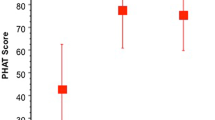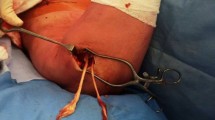Abstract
The aim of this article is to provide a state-of-the-art review for treatment of acute, total proximal hamstring tendon ruptures. For total proximal hamstring tendon ruptures, early (<2–3 w) surgical refixation minimizes muscle atrophy and facilitates a somewhat predictable time course for healing and rehabilitation. A postoperative rehabilitation program is detailed that has been used by one physical therapist for the past 7 years on over 200 patients with surgical repair for total proximal hamstring tendon rupture. One re-rupture has occurred, 7 months after surgery, following the rehabilitation program described herein. The rehabilitation program, including avoidance of postoperative bracing, appears effective for total proximal hamstring ruptures. Early surgery together with a specific rehabilitation program appears to be the treatment of choice for timely and safe return to sport and an active lifestyle.
Level of evidence V.





























Similar content being viewed by others
References
Askling CM, Tengvar M, Saartok T et al (2007) Acute first-time hamstring strains during high-speed running: a longitudinal study including clinical and magnetic resonance imaging findings. Am J Sports Med 35:197–206
Askling CM, Tengvar M, Saartok T et al (2007) Acute first-time hamstring strains during slow-speed stretching: clinical, magnetic resonance imaging, and recovery characteristics. Am J Sports Med 35:1716–1724
Askling CM, Nilsson J, Thorstensson A (2010) A new hamstring test to complement the common clinical examination before return to sport after injury. Knee Surg Sports Traumatol Arthrosc 18:1798–1803
Barrett T, Arthurs OJ (2010) Adductor magnus: a post-operative illustration of its dual nerve supply. Clin Anat 23:115–119
Benjamin M, Toumi H, Ralphs JR et al (2006) Where tendons and ligaments meet bone: attachment sites (‘entheses’) in relation to exercise and/or mechanical load. J Anat 208:471–490
Best TM, Garrett WE Jr (1996) Hamstring strains: expediting return to play. Phys Sportsmed 24:37–44
Birmingham P, Muller M, Wickiewicz T et al (2011) Functional outcome after repair of proximal hamstring avulsions. J Bone Joint Surg Am 93:1819–1826
Brucker PU, Imhoff AB (2005) Functional assessment after acute and chronic complete ruptures of the proximal hamstring tendons. Knee Surg Sports Traumatol Arthrosc 13:411–418
Carmichael J, Packham I, Trikha SP et al (2009) Avulsion of the proximal hamstring origin: surgical technique. J Bone Joint Surg Am 91(suppl 2):249–256
Clark BB, Jaffe D, Henn F III, Lovering RM (2011) Evaluation and imaging of an untreated grade III hamstring tear. Clin Orthop Relat Res 469:3248–3252
Clarke AW, Connell DA (2009) Case report: bilateral ischial stress fractures in an elite tennis player. Skeletal Radiol 38:711–714
Cohen S, Bradley J (2007) Acute proximal hamstring rupture. J Am Acad Orthop Surg 15:350–355
Connell DA, Schneider-Kolsky ME, Hoving JL et al (2004) Longitudinal study comparing sonographic and MRI assessments of acute and healing hamstring injuries. AJR Am J Roentgenol 183:975–984
De Smet AA, Best TM (2000) MR imaging of the distribution and location of acute hamstring injuries in athletes. AJR Am J Roentgenol 174:393–399
Ekstrand J, Hagglund M, Walden M (2011) Injury incidence and injury patterns in professional football: the UEFA injury study. Br J Sports Med 45:553–558
Ekstrand J, Healy JC, Waldén M et al (2012) Hamstring muscle injuries in professional football: the correlation of MRI findings with return to play. Br J Sports Med 46:112–117
Floor S, van der Veen AH (2010) Two patients with a complete proximal rupture of the hamstring. Arch Orthop Trauma Surg 130:523–526
Folsom GJ, Larson CM (2008) Surgical treatment of acute versus chronic complete proximal hamstring ruptures. Am J Sports Med 36:104–109
Gibbs NJ, Cross TM, Cameron M et al (2004) The accuracy of MRI in predicting recovery and recurrence of acute grade one hamstring muscle strains within the same season in Australian Rules football players. J Sci Med Sport 7:248–258
Gidwani S, Bircher MD (2007) Avulsion injuries of the hamstring origin—a series of 12 patients and management algorithm. Ann R Coll Surg Engl 89:394–399
Hamersly SF, Schrader M (2009) Postoperative rehabilitation of proximal hamstring tendon tears. Oper Tech Sports Med 17:219–224
Harris JD, Griesser MJ, Best TM, Ellis TJ (2011) Treatment of proximal hamstring ruptures—a systematic review. Int J Sports Med 32:490–495
Heiderscheit B, Sherry MA, Silder A, Chumanov ES, Thelen DG (2010) Hamstring strain injuries: recommendations for diagnosis, rehabilitation, and injury prevention. J Orthop Sports Phys Ther 40:67–81
Herneth AM, Trattnig S, Bader TR et al (2000) MR imaging of the ischiopubic synchondrosis. Magn Reson Imaging 18:519–524
Kirkland A, Garrison C, Singleton S, Rodrigo J, Boettner F, Stuckey S (2008) Surgical and therapeutic management of a complete proximal hamstring avulsion after failed conservative approach. J Orthop Sports Phys Ther 38:754–760
Klingele KE, Sallay P (2002) Surgical repair of complete proximal hamstring tendon rupture. Am J Sports Med 30:742–747
Konan S, Haddad F (2010) Successful return to high level sports following early surgical repair of complete tears of the proximal hamstring tendons. Int Orthop 34:119–123
Koulouris G, Connell D (2003) Evaluation of the hamstring muscle complex following acute injury. Skeletal Radiol 32:582–589
Koulouris G, Connell D (2005) Hamstring muscle complex: an imaging review. Radiographics 25:571–586
Koulouris G, Connell DA, Brukner P et al (2007) Magnetic resonance imaging parameters for assessing risk of recurrent hamstring injuries in elite athletes. Am J Sports Med 35:1500–1506
Kwak HY, Bae SW, Choi YS, Jang MS (2011) Early surgical repair of acute complete rupture of the proximal hamstring tendons. Clin Orthop Surg 3:249–253
Lempainen L, Sarimo J, Heikkilä J et al (2006) Surgical treatment of partial tears of the proximal origin of the hamstring muscles. Br J Sports Med 40:688–691
Lempainen L, Sarimo J, Orava S (2007) Recurrent and chronic complete ruptures of the proximal origin of the hamstring muscles repaired with fascia lata autograft augmentation. J Arth Rel Surgery 23(4):441–445
Linklater JM, Hamilton B, Carmichael J et al (2010) Hamstring injuries: anatomy, imaging, and intervention. Semin Musculoskelet Radiol 14:131–161
Orava S, Kukala UM (1995) Rupture of the ischial origin of the hamstring muscles. Am J Sports Med 23(6):702–705
Peetrons P (2002) Ultrasound of muscles. Eur Radiol 12:35–43
Pomeranz SJ, Heidt RS Jr (1993) MR imaging in the prognostication of hamstring injury. Work in progress. Radiology 189:897–900
Ripani M, Continenza MA, Cacchio A et al (2006) The ischiatic region: normal and MRI anatomy. J Sports Med Phys Fitness 46:468–475
Sallay PI, Friedman RL, Coogan PG, Garrett WE (1996) Hamstring muscle injuries among water skiers: functional outcome and prevention. Am J Sports Med 24:130–136
Sallay PI, Ballard G, Hamersly S, Schrader M (2008) Subjective and functional outcomes following surgical repair of complete ruptures of the proximal hamstring tendons. Orthopedics 31:1092–1102
Sallay PI (2009) Diagnosis, classification, and management of acute proximal hamstring avulsion injuries. Op Tech Sports Med 17:196–204
Sarimo J, Lempainen L, Mattila K, Orava S (2008) Complete proximal hamstring avulsions. A series of 41 patients with operative treatment. Am J Sports Med 36:1110–1115
Schache AG, Koulouris G, Kofoed W et al (2008) Rupture of the conjoint tendon at the proximal musculotendinous junction of the biceps femoris long head: a case report. Knee Surg Sports Traumatol Arthrosc 16:797–802
Scillia A, Choo A, Milman E et al (2011) Snapping of the proximal hamstring origin: a rare cause of coxa saltans: a case report. J Bone Joint Surg Am 93:1251–1253
Sherry MA, Best TM (2004) A comparison of 2 rehabilitation programs in the treatment of acute hamstring strains. J Orthop Sports Phys Ther 34:116–125
Silder A, Heiderscheit BC, Thelen DG, Enright T, Tuite MJ (2008) MR observations of long-term musculotendon remodeling following a hamstring strain injury. Skeletal Radiol 37:1101–1109
Slavotinek JP, Verrall GM, Fon GT (2002) Hamstring injury in athletes: using MR imaging measurements to compare extent of muscle injury with amount of time lost from competition. Am J Roentgenol 179:1621–1628
Stafford GH, Villar RN (2011) Ischiofemoral impingement. J Bone Joint Surg Br 93:1300–1302
Torriani M, Souto SC, Thomas BJ et al (2009) Ischiofemoral impingement syndrome: an entity with hip pain and abnormalities of the quadratus femoris muscle. Am J Roentgenol 193:186–190
Verrall GM, Slavotinek JP, Barnes PG et al (2001) Clinical risk factors for hamstring muscle strain injury: a prospective study with correlation of injury by magnetic resonance imaging. Br J Sports Med 35:435–439
Verrall GM, Slavotinek JP, Barnes PG et al (2003) Diagnostic and prognostic value of clinical findings in 83 athletes with posterior thigh injury: comparison of clinical findings with magnetic resonance imaging documentation of hamstring muscle strain. Am J Sports Med 31:969–973
Verrall GM, Slavotinek JP, Barnes PG et al (2006) Assessment of physical examination and magnetic resonance imaging findings of hamstring injury as predictors for recurrent injury. J Orthop Sports Phys Ther 36:215–224
Wait A, Gaskill T, Sarwar Z et al (2011) Van neck disease: osteochondrosis of the ischiopubic synchondrosis. J Pediatr Orthop 31:520–524
Wood DG, Packham I, Trikha PS et al (2008) Avulsion of the proximal hamstring origin. J Bone Joint Surg Am 90:2365–2374
Yamamoto T, Akisue T, Nakatani T et al (2004) Apophysitis of the ischial tuberosity mimicking a neoplasm on magnetic resonance imaging. Skeletal Radiol 33:737–740
Zissen MH, Wallace G, Stevens KJ et al (2010) High hamstring tendinopathy: MRI and ultrasound imaging and therapeutic efficacy of percutaneous corticosteroid injection. Am J Roentgenol 195:993–998
Acknowledgments
The authors thank Dr Sven Jönhagen, Danderyd Sjukhus, Stockholm, and Dr Karl Eriksson, Södersjukhuset, Stockholm, for their skilful cooperation and assistance.
Author information
Authors and Affiliations
Corresponding author
Rights and permissions
About this article
Cite this article
Askling, C.M., Koulouris, G., Saartok, T. et al. Total proximal hamstring ruptures: clinical and MRI aspects including guidelines for postoperative rehabilitation. Knee Surg Sports Traumatol Arthrosc 21, 515–533 (2013). https://doi.org/10.1007/s00167-012-2311-0
Received:
Accepted:
Published:
Issue Date:
DOI: https://doi.org/10.1007/s00167-012-2311-0




